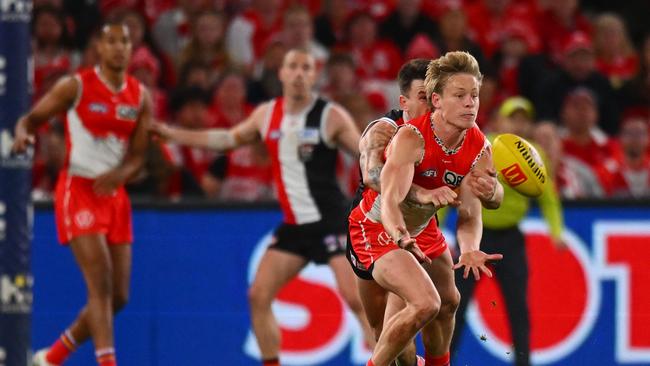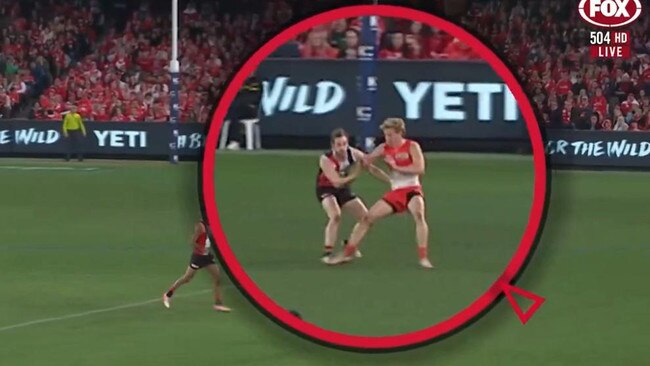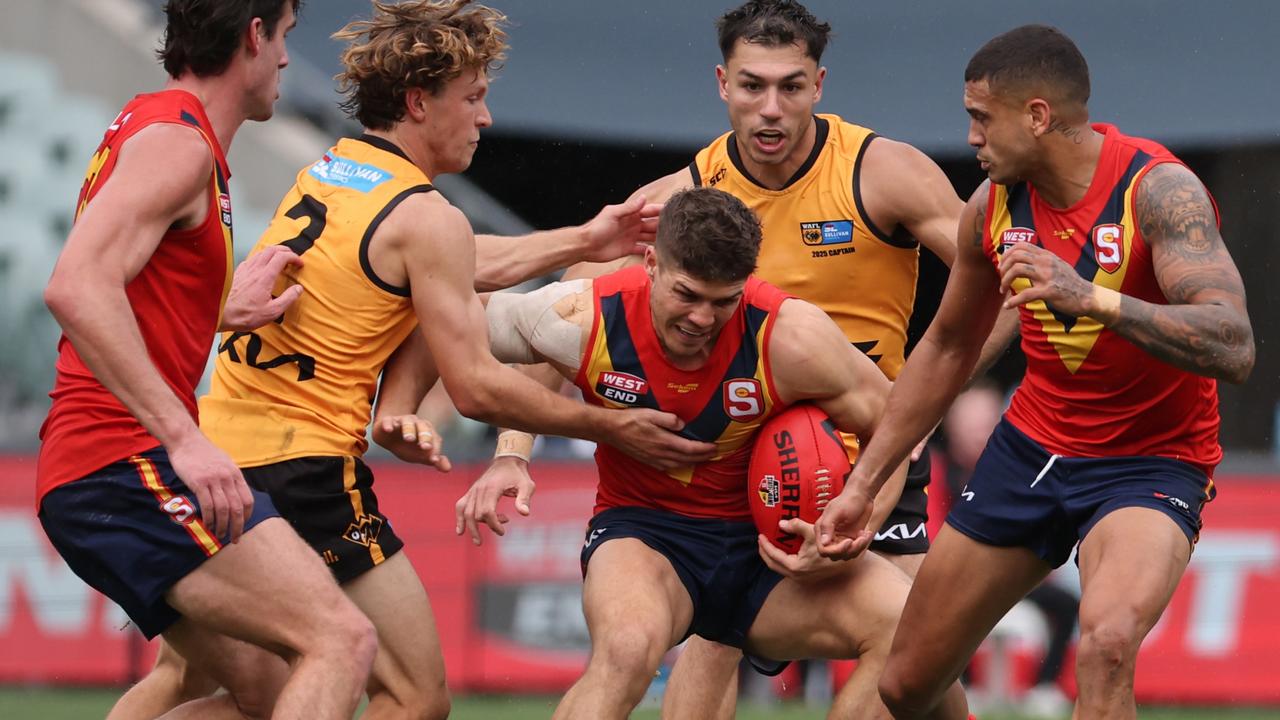Isaac Heeney’s suspension and ineligibility for Brownlow shows AFL penalties around ‘accidental’ contact too harsh | Graham Cornes
Isaac Heeney’s ban and ineligibility for the Brownlow Medal is the final straw for Graham Cornes, who says AFL used to be flint-hard but is now marshmallow-soft.
Opinion
Don't miss out on the headlines from Opinion. Followed categories will be added to My News.
Isaac Heeney is no longer eligible for the Brownlow Medal.
It’s a disgrace and an indictment on those faint-hearted souls that have shifted the image of our great game from flint-hard to marshmallow-soft.
It is also an indictment on the system – this ridiculous system under which offences are graded.
Heeney was no certainty to win football’s most coveted personal award. After all there is plenty of competition within that talented young Swans midfield, but he would have been one of the favourites.
HAVE YOUR SAY IN THE COMMENTS BELOW
The point is that one of the league’s most brilliant players is ineligible for what was accidental contact to his opponent, Jimmy Webster.
It was the blood that did it. Had Webster not sustained a blood-nose, the incident would have passed unnoticed. The blood was a giveaway.
The incident was remarkably similar to that involving Port’s Brandon Zerk-Thatcher, whose errant arm made contact with Bulldogs forward Aaron Naughton.
Naughton was subsequently subbed out of the game last week with a concussion. Yet Zerk-Thatcher is free to play because contact in that case was judged as neither intentional or careless. Rightly so.

Even though the consequences for Naughton were much more serious, any fair-minded observer would not blame Zerk-Thatcher for Naughton’s concussion.
Nor could a fair-minded observer blame Heeney for Webster’s bloody nose.
Heeney’s arm was swung backwards in an attempt to break free of Webster’s scragging but it was in a downward motion and an instinctive reaction from a player that was being harassed, grabbed and held off the ball.
If the umpires, all four of them, were doing their job properly, Heeney should have received a free kick.
This whole mess is caused by the AFL’s process of adjudicating incidents within the rigid framework that tabulates conduct (intentional or careless), impact (severe, high, medium, low) and where contact was made (high/groin or body).
Specific to Heeney’s case is whether the action was intentional or careless, and whether it happened in play or off the ball.
Ridiculous as it seems, there appears to be no category of “accidental”.
Having been slapped with the one-match ban by the Match Review Officer, Heeney understandably took the case to the AFL Tribunal, arguing that the action was in the category of a push or fend-off and as the ball was being kicked in both players’ direction, it should have been assessed as “in-play”, not “off-the-ball”.
But he had no friend in Jeff Gleeson, the tribunal chair. In a previous role he had been the AFL’s counsel and prosecuted each case with the zeal of a public prosecutor exacting retribution for heinous crimes.
He would not countenance the fact that the contact was unintentional and happened in-play.
He did not have, or chose not to use, discretion to clear Heeney.
Ironically, as revealed in The Advertiser on Thursday, the Sydney Swans had written to the AFL in January protesting new rule amendments which determined what would constitute a strike and what was intentional or careless. They did not hear back from them.
We have entered an era of ultra-sanitisation.
Of course the game had to be cleaned up. There has been a history of violence where off-the-ball incidents and front-on collisions did permanent damage.
Google “Biffs, Bumps and Brawlers” and you will get some idea of the violence that was celebrated in 20th century Australian rules football. Ironically the crowds loved it. We shouldn’t be surprised.

After all, Mixed Martial Arts, that most brutal and violent of sports, sells out stadiums. Such is the primeval thirst for blood.
But before it was commercialised, football was supposed to be for fun – an escape from the working man’s week; the cathartic release of pent-up emotions
However, it wasn’t always fun. The game regarded as the most violent in the VFL/AFL history is the 1945 VFL grand final between South Melbourne and Carlton.
Unfortunately, only a few minutes of grainy black and white vision exists and shows little of the violence for which the game is infamous.
Just weeks after the cessation of hostilities in Europe, this game was held at Princes Park, Carlton’s home ground, because the MCG had been requisitioned by the Commonwealth Government for military purposes. (The MCG had been occupied by US Army, Marines, and Airforce as well as our RAAF). The timing of the match is significant.
Perhaps in the aftermath of World War II a battle-weary population was inured to the violence.
Maybe those footballers were infused with a wartime fervour which made the aggression instinctive. Conversely, those living with an inferiority complex of not having served may have felt they had something to prove.
Incredibly over 62,000 spectators crammed into Princes Park. The local press described the game as follows: “Punching, kicking and deliberate assaults made the league grand final at Carlton on Saturday one of the worst in history … Many people left the ground disgusted with what they saw … Officials of the two clubs expressed disgust at the unsavoury end of an excellent season. Each blamed the other for starting the brawls.”
The violence continued until the final siren as Carlton triumphed by 28 points.
The Blues had snuck into the top four, trailed Collingwood by nearly five goals at three quarter time of an equally violent preliminary final, but stormed home.
They would claim the end justified the violence but the Melbourne newspaper, Truth, called it “the most repugnant spectacle league football has ever known”.
Ten players were reported in a game that has forever been known as “The Bloodbath.”
The advent of television in 1956 exposed the violence of the game and slowly the football thugs were brought to account, but there were still isolated matches where teams went to war.
The infamous brawl at Windy Hill involving players and officials from Richmond and Essendon in 1974 brought the game into disrepute, as did the “line in the sand” match between Essendon and Hawthorn in 2004.
Then there was the 1990 grand final brawl between Collingwood and Essendon when a young Gavin Brown was knocked unconscious by Terry Daniher.
Here in Adelaide we had the 1991 grand final between North Adelaide and West Adelaide with unprecedented scenes of violence and rolling melees.
North Adelaide won but looking at Steven Sims’s right eye, you wouldn’t have thought so.

Those days are long gone. Television scrutiny from all angles exposed the thugs and called them to account but the pendulum has swung too far.
Today we see accidental or incidental football collisions and contact like Isaac Heeney’s punished too harshly.
Adelaide’s Izak Rankine was also reported last weekend but it’s hard to defend him.
Instead of holding his ground he moved to bump an unsuspecting Brisbane player, Brandon Starcevich.
You can question whether the four-match penalty was too severe but front-on bumps to unsuspecting players are the hits that the AFL is trying to remove from the game. No argument. But otherwise the scrutiny is too harsh and the penalties too severe.
Brownlow Medallist, Gary Dempsey played 329 games without being reported, Barry Round 328.
Dick Reynolds won three Brownlow Medals over a 320-game career in which he was never reported.
They wouldn’t get away with it in today’s football. Why should Isaac Heeney be playing under such different rules?





